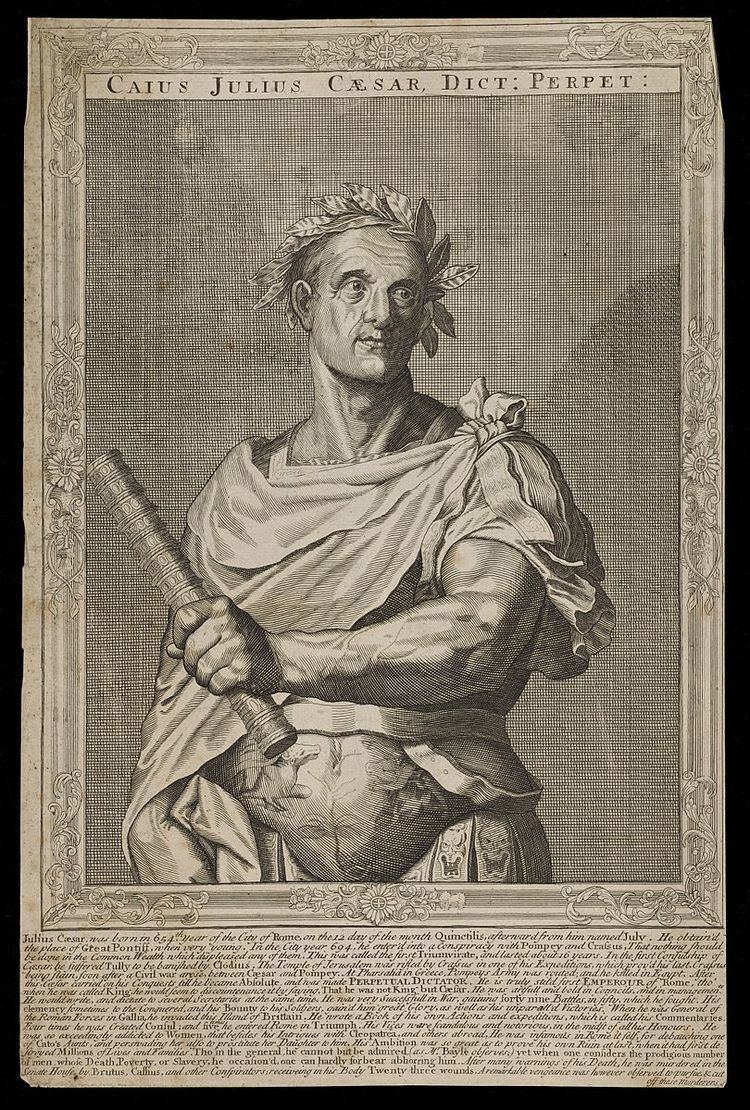 | ||
Similar Flora, Venus and Adonis, Sacred and Profane Love, La Schiavona, Venus of Urbino | ||
The Eleven Caesars was a series of eleven paintings of half-busts of Roman emperors painted by Titian in 1536-40 for Federico II, Duke of Mantua. The original busts were among Pieve di Cadore's best-known works, inspired by the Lives of the Caesars by Suetonius. Titian's paintings were originally to have been housed in a new room inside the Palazzo Ducale di Mantova. Bernardino Campi added a twelfth portrait in 1562.
The portraits were copied by Flemish engravers in the late 16th and early 17th centuries, who added engravings of twelve Roman Empresses. Between 1627 and 1628 the paintings were sold to Charles I of England by Vincenzo II Gonzaga, and when the Royal Collection of Charles II of England broken up during the English Commonwealth, the Eleven Caesars passed into the collection of Philip IV of Spain in 1651.
Titian's original paintings were destroyed in a catastrophic fire at the Royal Alcazar of Madrid in 1734, and are now only known from copies and engravings.
History
The portraits were commissioned in 1536 for the Gabinetto dei Cesari, a new suite of rooms designed by Giulio Romano inside the Palazzo Ducale di Mantova, whose decoration was inspired by ancient history. Titian was inspired by Suetonius's account of the Lives of the Twelve Caesars and informed by Titian's study of ancient medals and busts, as well as a series of sculptures by Pieve di CadoreTitian completed portraits of eleven emperors before the death of Federico in August 1540.
The emperors were depicted in classical poses, wearing armour and flowing draped clothing, accompanied by various object such as swords and staffs. Titian's eleven portraits were copied by Bernardino Campi in 1561 for Francesco Ferdinando d'Ávalos, governor of Milan. To Titian's eleven portraits, Campi added the twelfth Caesar, Domitian, in 1562, after a portrait by Giulio Romano. Campi returned to the subject several times, painting at least another four sets for other patrons.
Drawings of Titian's originals were made by Ippolito Andreasi in about 1568. They were engraved by Aegidius Sadeler II and published in Antwerp in about 1593, and then republished by Marcus Sadeler in about 1625. Both were court artists to Emperor Rudolf II in Prague. The engravers added twelve accompanying empresses - eleven wives and Otho's mother, Albia Terentia - based on portraits by Giulio Romano. Each engraved portrait is accompanied by a poem in Latin. The engravings are an important source for the details of Renaissance armour, including examples attributed to Filippo Negroli.
The Gonzaga collection, including Titian's paintings, was sold by Vincenzo II Gonzaga to Charles I of England in 1628, but Charles's Royal Collection was broken up and auctioned under the English Commonwealth. The Titian portraits were sold in 1651 to the Spanish Ambassador Alonso de Cárdenas, acting on behalf Don Luis Méndez de Haro, and he gave them to Philip IV of Spain. Some works by Giulio Romano, or his workshop, designed to hang below the portraits are in the British Royal Collection.
Titian's portraits were displayed at the Royal Alcazar of Madrid, along with other portraits by Titian and Tintoretto, where the Galería del Mediodía (the South gallery) became known as the Galería de Retratos (Portrait Gallery). They were lost in the catastrophic fire that destroyed the Alcázar in 1734
